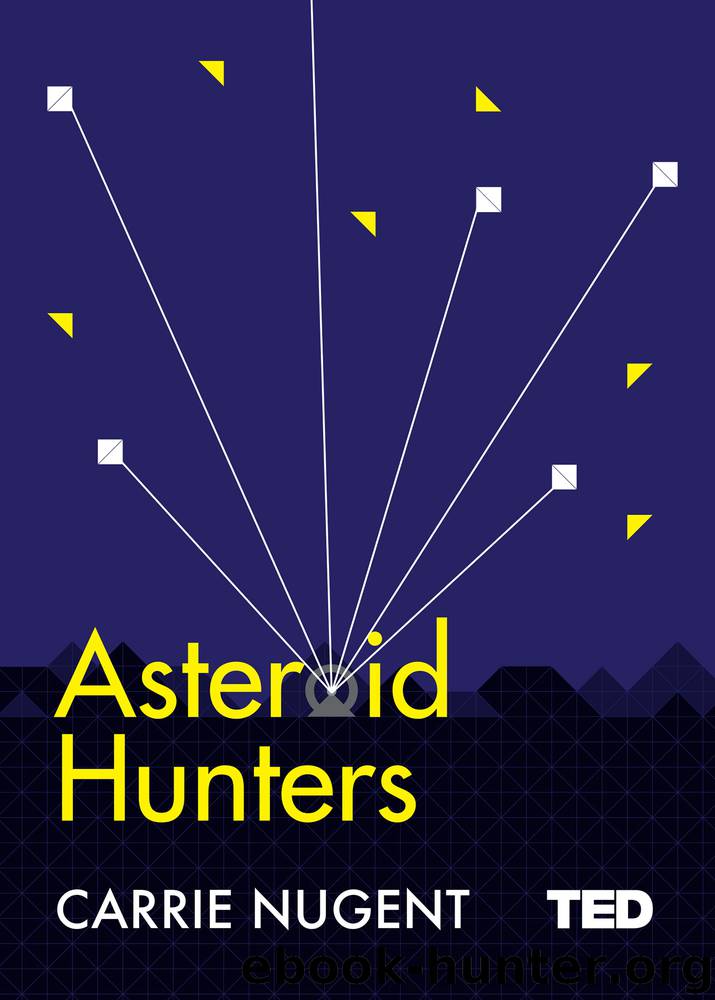Asteroid Hunters by Carrie Nugent

Author:Carrie Nugent
Language: eng
Format: epub
Publisher: Simon & Schuster UK
6
My Favorite Telescope
Most asteroid hunters use telescopes sensitive to the wavelengths of light that our eyes can see. But there’s one asteroid-hunting telescope that uses a different type of light. That telescope is called NEOWISE, and it is my favorite. I’m part of the team of scientists that gets to use it to find and study asteroids.
NEOWISE sees the sky in the thermal infrared, which means it sees heat. To understand how that works, you need to know that all warm things glow. You’ve probably seen the red glow of molten glass or metal, which are so hot they glow at visible wavelengths. As it turns out, things at cooler temperatures also glow, but at infrared wavelengths human eyes can’t see. If you could see your surroundings right now in the infrared, you’d see that everything around you is glowing.
So when NEOWISE spots an asteroid, it’s detecting the heat that asteroid is emitting. This gives NEOWISE a key advantage. Some asteroid surfaces are as dark as coal and reflect very little light. This makes them very hard to see if you’re looking in visible wavelengths. But all asteroids are warmed by the Sun, making them glow in the infrared and shine brightly for NEOWISE.
The other nifty thing about looking at asteroids in the infrared is that you can measure how big they are. If you look at an asteroid in visible light, you cannot tell if it is a small, bright object or if it’s big and dark. They both could reflect the same amount of light.
However, the amount of thermal light that an asteroid emits scales with size; the bigger it is, the more thermal light it will emit. So with NEOWISE, we can actually measure the sizes of asteroids. Although it seems like one of the first things you might learn about an asteroid, we don’t yet know the sizes of most of them. This is because most asteroids have not yet been detected in the infrared. Thanks to NEOWISE and other infrared telescopes, we have good size estimates for about one in every five known asteroids.
The thermal infrared is pretty great for studying asteroids. So why is NEOWISE the only full-time infrared telescope hunting asteroids?
Well, it’s not easy to build an infrared telescope, and this is partly because everything on Earth is warm enough to glow in the infrared, including telescopes. The faint glow of a distant warm asteroid is hard to see if the telescope you’re looking through is also glowing brightly. To prevent this, astronomers have to keep their infrared telescopes very cold, dimming this glow.
Additionally, there’s the problem of Earth’s atmosphere. Although great for breathing, the atmosphere can be very annoying to astronomers, as it blocks some infrared wavelengths from reaching the ground.
Astronomers can sidestep these problems by putting their telescope on top of a gigantic rocket and launching it off the planet. So that’s where NEOWISE is, right now. Up in space, far above Earth.
There are lots of advantages to having an off-planet telescope.
Download
This site does not store any files on its server. We only index and link to content provided by other sites. Please contact the content providers to delete copyright contents if any and email us, we'll remove relevant links or contents immediately.
| Aeronautics & Astronautics | Astronomy |
| Astrophysics & Space Science | Comets, Meteors & Asteroids |
| Cosmology | Mars |
| Solar System | Star-Gazing |
| Telescopes | UFOs |
Tools of Titans by Timothy Ferriss(8303)
Turbulence by E. J. Noyes(7977)
Secrets of Antigravity Propulsion: Tesla, UFOs, and Classified Aerospace Technology by Ph.D. Paul A. Laviolette(5330)
Astrophysics for People in a Hurry by Neil DeGrasse Tyson(5149)
Room 212 by Kate Stewart(5067)
Design of Trajectory Optimization Approach for Space Maneuver Vehicle Skip Entry Problems by Runqi Chai & Al Savvaris & Antonios Tsourdos & Senchun Chai(5036)
Pale Blue Dot by Carl Sagan(4949)
The David Icke Guide to the Global Conspiracy (and how to end it) by David Icke(4653)
A Journey Through Divination and Astronomy by Publishing Pottermore(4363)
Goodbye Paradise(3760)
Apollo 8 by Jeffrey Kluger(3664)
COSMOS by Carl Sagan(3584)
Losing the Nobel Prize by Brian Keating(3518)
The Five People You Meet in Heaven by Mitch Albom(3515)
How to Read Water: Clues and Patterns from Puddles to the Sea (Natural Navigation) by Tristan Gooley(3430)
Brief Answers to the Big Questions by Stephen Hawking(3392)
How to Read Nature by Tristan Gooley(3289)
The Order of Time by Carlo Rovelli(3162)
A Brief History of Time by Stephen Hawking(2990)
